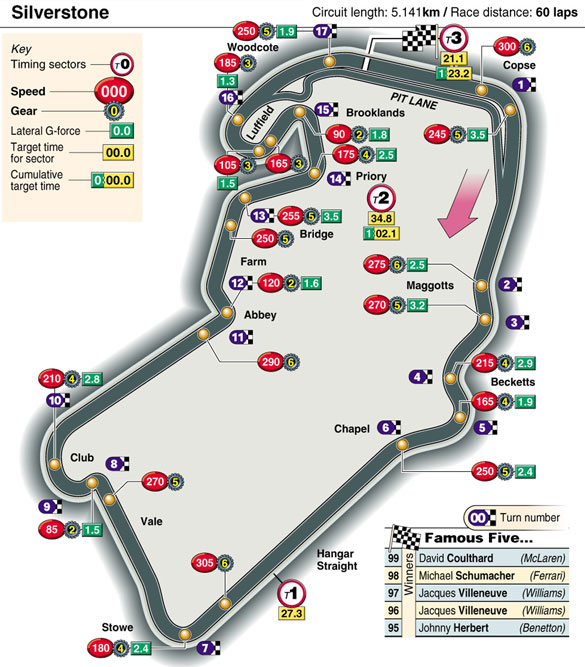|
| |||
 |
Everything You Need to Know about Silverstone (and More) | ||
 Opinions are divided about Silverstone among the drivers - especially the Brits. Whilst it's true that some points are a little bit 'point and squirt', other corners - notably the Becketts complex - are superb. As the drivers cross the start-finish line, they are flat out in sixth and reach 290 km/h before braking - and flicking down one or two gears - for Copse. Copse used to be nearly flat in sixth gear, but was revised to a third gear corner after the deaths in 1994, and although it has been made faster it is still not as fast as it was. It was revised again earlier last year, speeding it back up. Next are Maggots, Becketts and Chapel. With the exception of Eau Rouge, the Maggots-Becketts-Chapel complex is probably the most demanding and technical set of turns of any Grand Prix circuit in the world. The track flicks fast left, fast right, change down two gears, and exit a fast right - it's that quick! The driver will be experiencing in excess of 2G lateral force as he negotiates each corner, struggling all the time to point the car in the right direction. There's no rest for the drivers, however, as they scream down the Hangar Straight passing under the Mobil bridge. The next corner, Stowe, has been remodelled, as 1995's and, subsequently, 1996's revised versions were considered a little too tame for Formula One. The right-hand corner is taken in fourth at an estimated 180 km/h. The cars then pass through the Vale straight and enter the tight, second gear, left hander at Club. Drivers then enter a tight right-hander that opens up at the exit, allowing them to accelerate hard and briefly reach sixth gear before braking for the Abbey chicane. Accelerating out of Abbey, usually taken in second, the cars pass through the flat out, right-hand bend: Bridge. The next few corners - Priory, Brooklands and Luffield - were a fairly dull series of second gear, left and right handers in years past. However, Brooklands and Luffield have been re-profiled to allow a faster, more flowing transition into Woodcote. The exit to Luffield is important, as it leads to Woodcote - a flat out right hander - and onto the main straight where the tough process begins once again. A Lap of Silverstone with Eddie Irvine: "The run down to the first corner at Copse is amazingly fast now with a slight brake and maybe even a downchange. The Maggots / Becketts section is very, very fast. It's left, right, left, right, left and you're kept very busy. It's important to try not to brake and keep the thing flowing, keeping the car on the limit all the time. You obviously want to keep your speed up for the exit on to the Hangar Straight. "That's where we reach our maximum speed - about 200 km/h. "At the end of it you've got the very fast Stowe corner. It's bumpy through there and very fast and demanding. That's followed by a short straight down to the club section, which breaks up the rhythm a bit. There's a very slow left - hander and very slow right - hander and you get a wheelspin out of it. It's easy to make a mistake there. Then comes the run up the hill to the Abbey chicane, a left hander which is taken in third gear. That leads into Bridge and the Stadium section. I once went off at Bridge in practice, when the car bottomed out on my first lap out of the pits! You're not going so fast into Bridge these days and it should be flat but you've got to try to keep tight for that next left hander, Priory. "Priory is quite fast compared to the next left at Brooklands and then Luffield. The last double right hander is taken in second or third gear, depending on your set - up. Then it's on the power, round Woodcote and back past the pits for another lap."
Weekend milestones:
|
| Atlas F1 | © 2000 Kaizar.Com, Incorporated. |
| Send comments to: comments@atlasf1.com | Terms & Conditions |
Eddie Irvine's Lap of Silverstone appears courtesy of The Silverstone Official Website | |